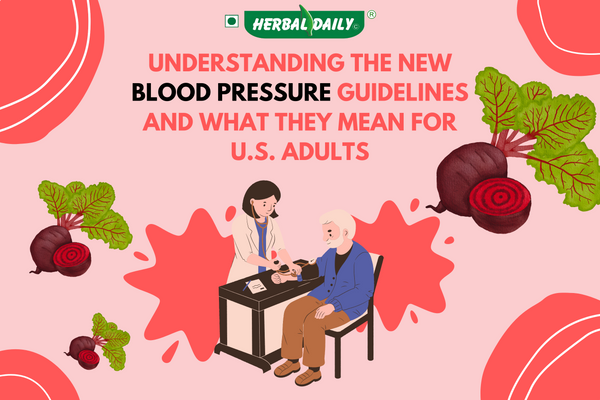Understanding the New Blood Pressure Guidelines and What They Mean for U.S. Adults

Understanding the New Blood Pressure Guidelines and What They Mean for U.S. Adults
Introduction: The First Update in Blood Pressure Standards in 14 Years
The American Heart Association (AHA) recently updated its guidelines for healthy blood pressure, marking the first change in 14 years. This new approach redefines what constitutes a healthy blood pressure range and affects close to half of U.S. adults. This article explains what these guidelines mean, who is impacted, and how individuals can adapt to maintain heart health.
What Has Changed in Blood Pressure Guidelines?
Previously, around 32% of U.S. adults were considered to have high blood pressure. Under the new guidelines, this figure has increased to 46%. The AHA’s revised criteria for defining blood pressure levels include a new "elevated blood pressure" category to help people recognize and address potential risks early.
Key Blood Pressure Classifications in the New Guidelines
The AHA’s updated categories are as follows:
- Normal Blood Pressure: Less than 120/80 mm Hg
- Elevated Blood Pressure: 120-129/<80 mm Hg
- Stage 1 Hypertension: 130-139/80-89 mm Hg
- Stage 2 Hypertension: 140 or higher/90 or higher mm Hg
- Hypertensive Crisis: Higher than 180/120 mm Hg, requiring immediate medical attention
This new classification system helps people understand where they fall on the spectrum and encourages early intervention when necessary.
Understanding "Elevated Blood Pressure"
The new "elevated blood pressure" category identifies a range between normal and high blood pressure. It helps doctors and patients address health concerns before they progress into hypertension, which can lead to long-term health issues if untreated.
Recommendations for People with Elevated Blood Pressure
For individuals in this range, the AHA suggests focusing on lifestyle adjustments rather than medication. These recommendations include:
- Heart-Healthy Diet: Reducing sodium and eating more potassium-rich foods like bananas, avocados, potatoes, and leafy greens
- Physical Activity: Engaging in moderate exercise, such as walking, swimming, or cycling, for at least 150 minutes each week
- Weight Management: Maintaining a healthy weight to help reduce cardiovascular strain
- Alcohol and Tobacco Moderation: Reducing alcohol intake and avoiding smoking to support heart health
These changes are intended to prevent elevated blood pressure from progressing into hypertension.

Younger Adults and the New Guidelines
The new standards have a notable impact on people under 45. The number of men in this age group classified with high blood pressure has tripled, while the number of women has doubled. This indicates that high blood pressure is becoming a concern at a younger age than before.
How This Affects Younger People
With younger adults increasingly affected by high blood pressure, early lifestyle changes can make a meaningful difference. Regular screenings, maintaining a balanced diet, managing stress, and staying active can all help prevent the progression of high blood pressure in this age group.
Emphasizing a Lifestyle Approach to Managing Blood Pressure
The AHA encourages healthcare providers to focus on lifestyle-based solutions rather than immediately prescribing medication for those in the early stages. This approach, known as a “framework of healthier lifestyle changes,” addresses the root causes of high blood pressure through dietary adjustments, exercise, and stress management.
Key Lifestyle Recommendations
- Balanced Diet: A diet rich in vegetables, fruits, whole grains, and lean proteins supports cardiovascular health.
- Limiting Sodium: Reducing processed foods and cooking with fresh ingredients lowers sodium intake.
- Including Potassium-Rich Foods: Foods high in potassium can help balance sodium levels and support blood vessel health.
- Regular Exercise: Routine physical activity supports weight management, reduces stress, and improves heart function.
- Managing Stress: Practicing relaxation techniques, such as deep breathing or meditation, can contribute to overall well-being.
How Healthcare Providers and Patients Can Work Together
The AHA recommends that healthcare providers educate patients on these guidelines and the importance of regular blood pressure monitoring. According to Dr. Paul Whelton, a public health expert, patients should be aware of their health risks and feel supported in making small but meaningful lifestyle adjustments.
Encouraging Gradual, Consistent Changes
Doctors are encouraged to help patients make incremental changes, such as adding one or two heart-healthy habits at a time. This approach can make it easier for individuals to develop habits that positively impact their long-term health.
The Broader Impact of New Blood Pressure Guidelines
The updated guidelines may lead to increased public health initiatives that emphasize preventive care. Workplace wellness programs, community health resources, and health education efforts may expand as a result, helping more people manage their blood pressure before it becomes a serious issue.

Conclusion: Taking a Practical Approach to Heart Health
The AHA’s new guidelines aim to provide a clear, practical framework for managing blood pressure. By focusing on lifestyle improvements, regular monitoring, and early intervention, more people can take steps to protect their cardiovascular health. These updated guidelines encourage individuals to prioritize small but consistent lifestyle choices that support long-term well-being, allowing healthcare providers and patients to work together toward better outcomes.
Nitric oxide supplements offer promising health benefits: Herbal Daily goodbeets
Keywords:
- Nutrients and calories
- Blood pressure
- Good for athletes
- Anti-inflammatory
- Digestive health
- Brain health
- Anti-cancer
- Energy balance
- How to eat
- Recipe tips: Juice and other uses
- FAQ
- Bottom line
To order in United States of America USA - www.dadiherbs.com
Amazon- HERBAL DAILY/ AMAZON.COM
